Research
Research Overview
Research Mission
Advancing our understanding and improving the predictability of Earth system processes.
My research aims to understand and predict Earth system processes across subseasonal, seasonal, decadal, and longer timescales. Specifically, I focus on advancing our understanding of the physical mechanisms that govern the climate system, enhancing the predictability of hydroclimate variability, and improving climate forecasting systems through the integration of dynamical models and statistical approaches. This research supports actionable decision-making for water resource management, wildfire mitigation, and ecological resilience—especially in regions like the western United States where climate extremes pose increasing challenges. By bridging fundamental climate science with real-world applications, I seek to build predictive tools that serve both scientific advancement and societal needs.
Research Themes
Climate Dynamics
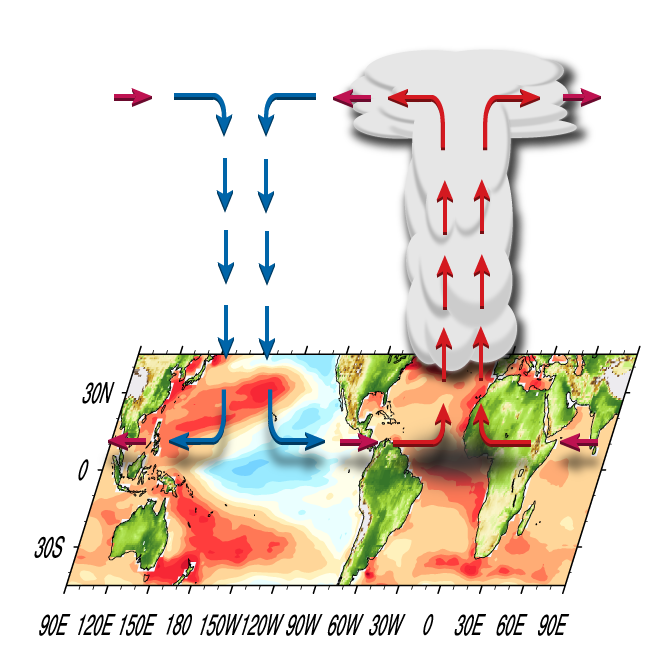
Exploring the coupled dynamical systems between the atmosphere and oceans, with a focus on inter-basin interactions, ENSO dynamics, and air-sea feedback processes that drive climate patterns across the globe.
Earth System Predictability

Quantifying the limits and opportunities of Earth system processes on longer timescales, linking drought, streamflow, weather extremes, wildfires, air quality, and ecosystem responses to large-scale climate variability and change.
Climate Forecasting Systems

Advancing a climate forecasting system through innovations in seasonal-to-decadal prediction frameworks, including initialization techniques, ensemble-based strategies, and statistical approaches.
Research Highlights
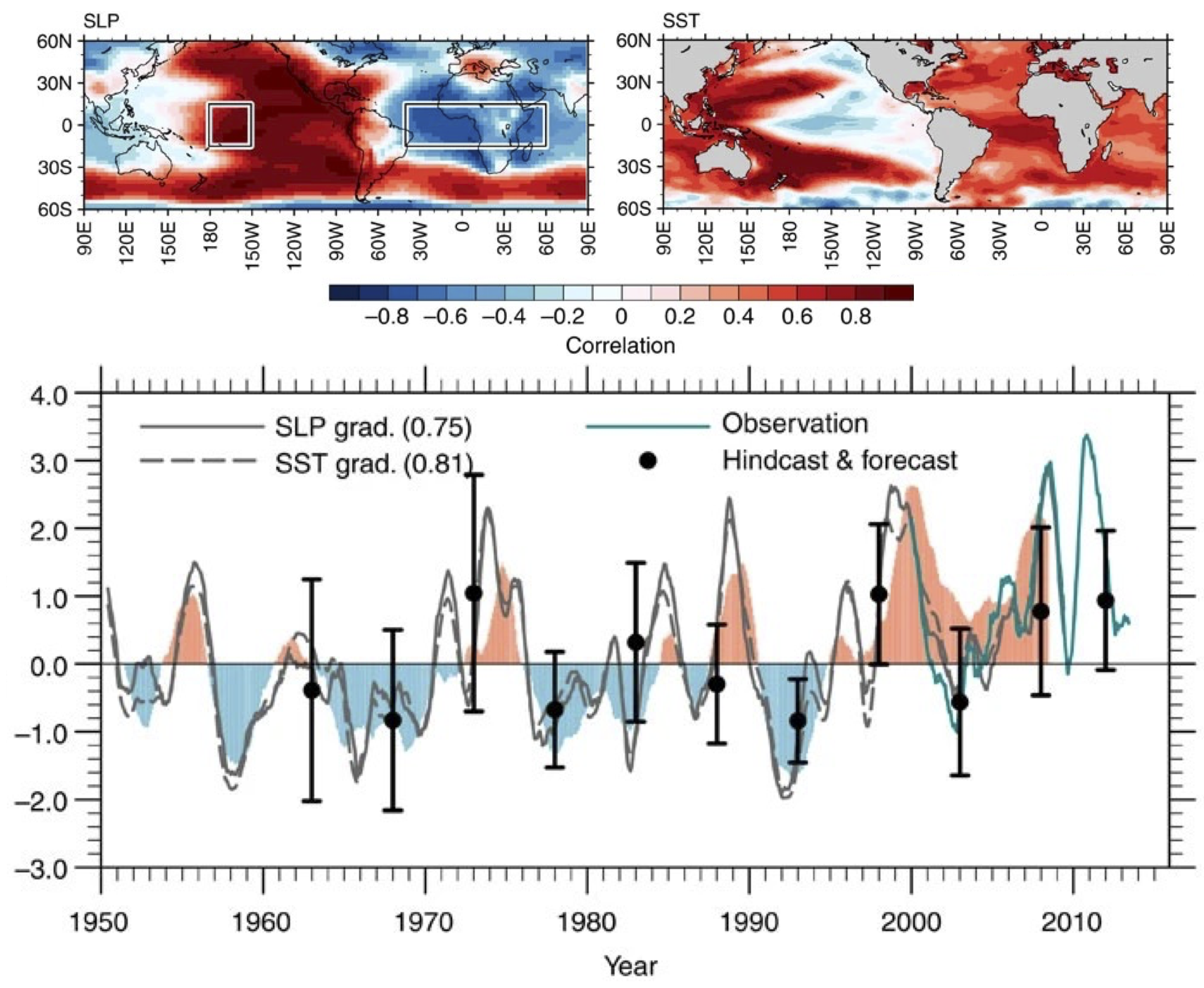
Inter-basin Interactions
Exploring dynamical processes through which tropical ocean basin interactions across the Pacific, Atlantic, and Indian Oceans shape variability on interannual to multi-decadal timescales.
Tropical Inter-Basin Interactions: Mechanisms and Predictability
Our research investigates how tropical climate variability in each ocean basin modulates variability in the others, and explores the underlying mechanisms. Using observational analyses and coupled climate model experiments, we demonstrate that the Atlantic and Indian Oceans can influence tropical Pacific climate variability on interannual and longer timescales. These findings challenge the traditional view that the tropical Pacific is the sole driver of global climate variability and contribute to extending the current upper limit of climate predictability beyond several seasons. Our results highlight the importance of accounting for pan-tropical interactions in advancing climate prediction.
Key Publications:- Cai et al. (2019, Science): Pantropical climate interactions
- Chikamoto et al. (2016, GRL): Potential tropical Atlantic impacts on Pacific decadal climate trends
- Mochizuki et al. (2016, GRL): Inter-basin effects of the Indian Ocean on Pacific decadal climate change
- Chikamoto et al. (2015, Nat. Commun.): Skilful multi-year predictions of tropical trans-basin climate variability
- McGregor et al. (2014, Nat. Clim. Change): Recent Walker Circulation strengthening and Pacific cooling amplified by Atlantic warming
- Chikamoto et al. (2012, GRL): Relationship between the Pacific and Atlantic stepwise climate change during the 1990s
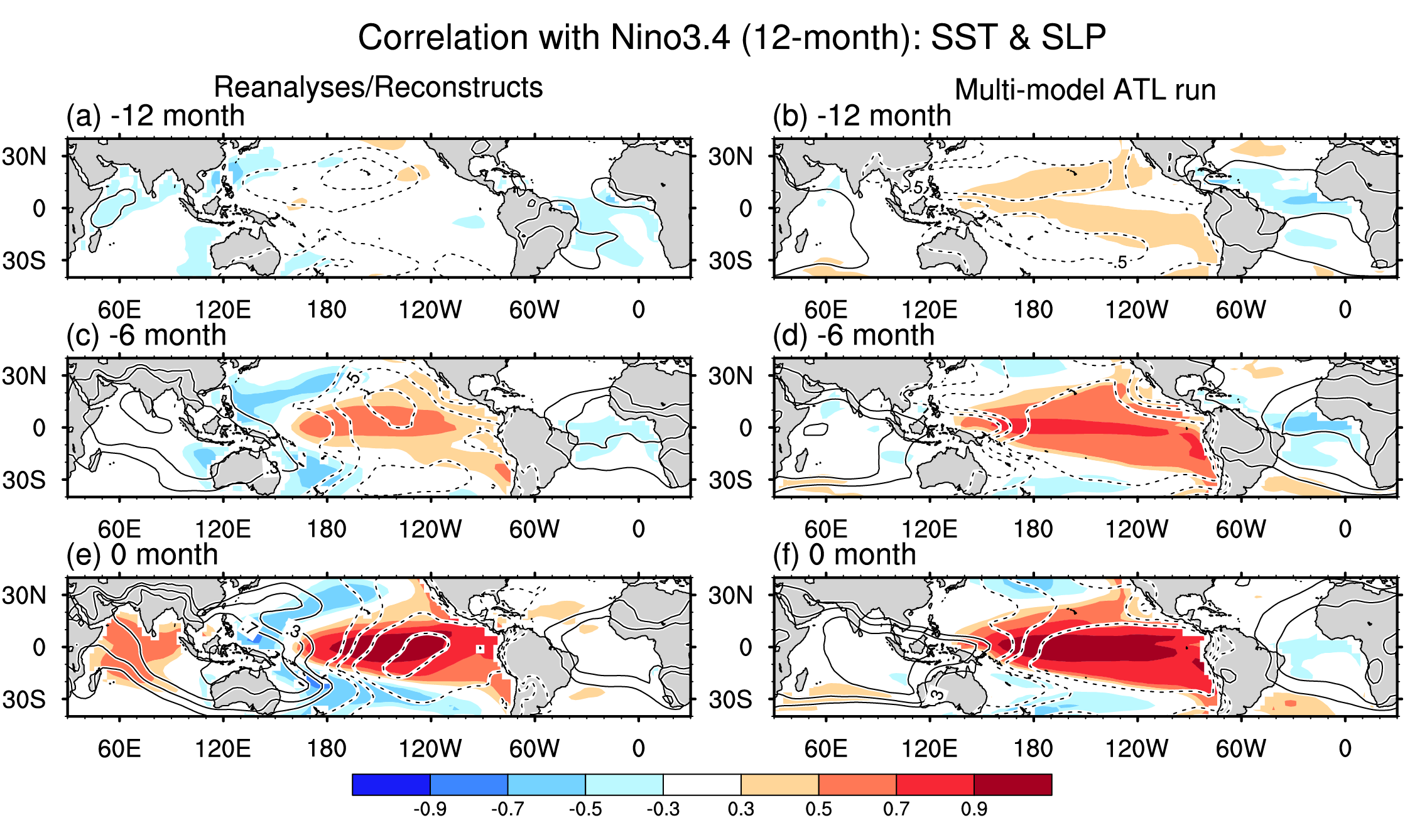
ENSO Predictability
Understanding physical processes that shape the evolution and predictability of El Niño and La Niña, especially for multi-year events.
ENSO Dynamics and Predictability
Our research aims to improve understanding of El Niño–Southern Oscillation (ENSO) dynamics and to extend its seasonal-to-multi-year predictability. We focus on the physical mechanisms behind ENSO evolution, diversity, and duration, and their application to improve ENSO predictability. In particular, we emphasize multi-year La Niña events and the role of tropical inter-basin interactions. By integrating coupled climate models and observational analyses, we seek to provide a more comprehensive understanding of the limits and opportunities in ENSO predictability.
Key Publications:- Hasan et al. (2022, Front. Clim.): The influence of tropical basin interactions on the 2020–2022 double-dip La Niña
- Chikamoto et al. (2020, JGR: Oceans): ENSO evolution in trans-basin interaction context
- Timmermann et al. (2018, Nature): ENSO complexity
- Imada et al. (2015, Mon. Wea. Rev.): Predictability of two types of El Niño using MIROC
- Chikamoto et al. (2010, J. Meteor. Soc. Japan): Subtropical Pacific SST variability during the early stage of ENSO
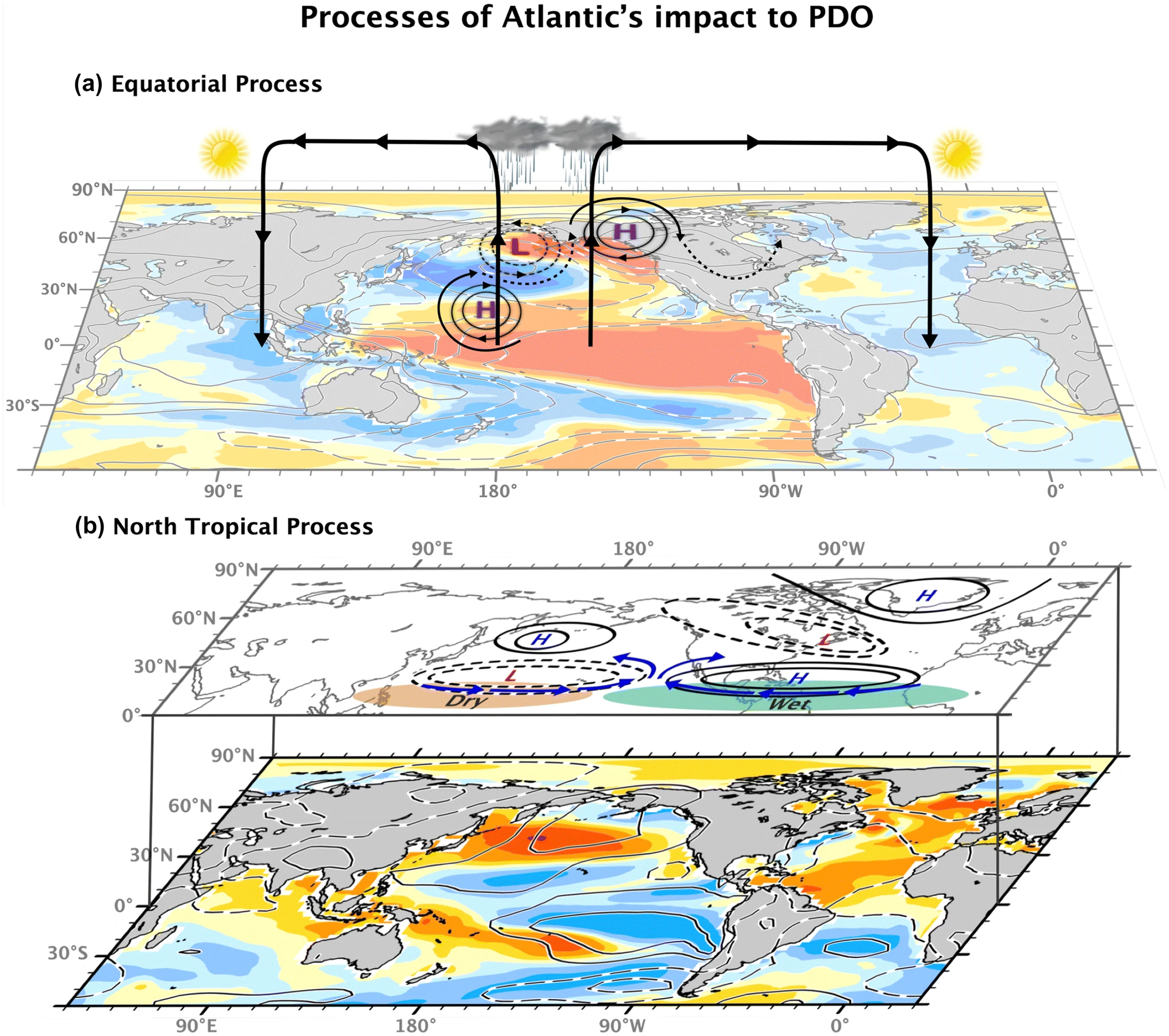
Teleconnection
Investigating how atmospheric teleconnections regulate climate variability and link tropical ocean processes with remote impacts.
Atmospheric Teleconnections in Climate Systems
Our research examines how ocean forcing modulates large-scale atmospheric circulation through air-sea interactions. We explore teleconnection mechanisms associated with ocean variability, such as ENSO, Pacific Decadal Variability, and Atlantic Multidecadal Variability, as well as atmospheric changes including the Walker circulation, Pacific-North American pattern, and tropical–extratropical interactions. These studies are essential for understanding the remote effects of tropical variability and for improving long-range climate prediction.
Key Publications:- Johnson et al. (2020, Clim. Dyn.): Pacific Decadal Oscillation remotely forced by the equatorial Pacific and the Atlantic Oceans
- Stuecker et al. (2017, GRL): Revisiting ENSO–Indian Ocean Dipole phase relationships
- Purich et al. (2016, J. Climate): Tropical Pacific Drivers of Antarctic Sea Ice
- Chikamoto and Tanimoto (2006, GRL): Air-sea humidity effects on tropical Atlantic SST anomalies during ENSO
- Chikamoto and Tanimoto (2005, J. Meteor. Soc. Japan): Role of specific humidity anomalies in Caribbean SST response to ENSO
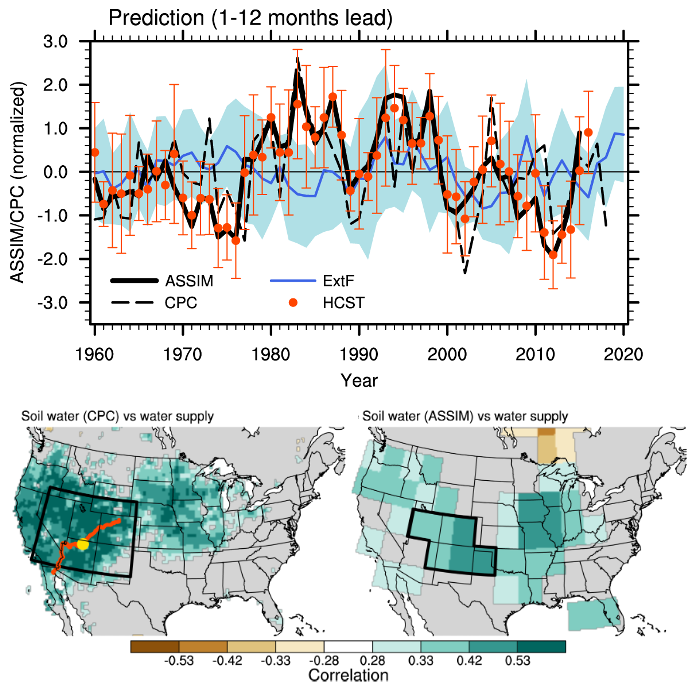
Hydrological Predictability
Predicting precipitation, droughts, river flow, and hydroclimate risk across North America and the globe using ocean memory and Earth system modeling.
Hydrological Predictability on Seasonal-to-Decadal Timescales
Predicting precipitation and subsequent river streamflow over long timescales is an important but challenging research topic. Our work focuses on how precipitation variability is modulated by large-scale climate forcings, including ocean memory and inter-basin interactions. We demonstrate that sea surface temperature (SST) precursors enable skillful multi-year forecasts of Colorado River water supply, providing actionable information for water resource planning, drought resilience, and climate adaptation strategies across the western United States.
Key Publications:- Chikamoto et al. (2020, Comm. Earth Environ.): Predictability of Colorado River water supply from ocean memory
- Chikamoto et al. (2024, J. Climate): Late-Spring Precipitation Variability in the Southern Great Plains
- Johnson et al. (2018, Climate): Ocean impacts on Australian Precipitation variability
- Ham et al. (2017, Clim. Dyn.): Tropical Atlantic-Korea teleconnection pattern
- Stevenson et al. (2015, J. Climate): Stochastically Generated North American Megadroughts
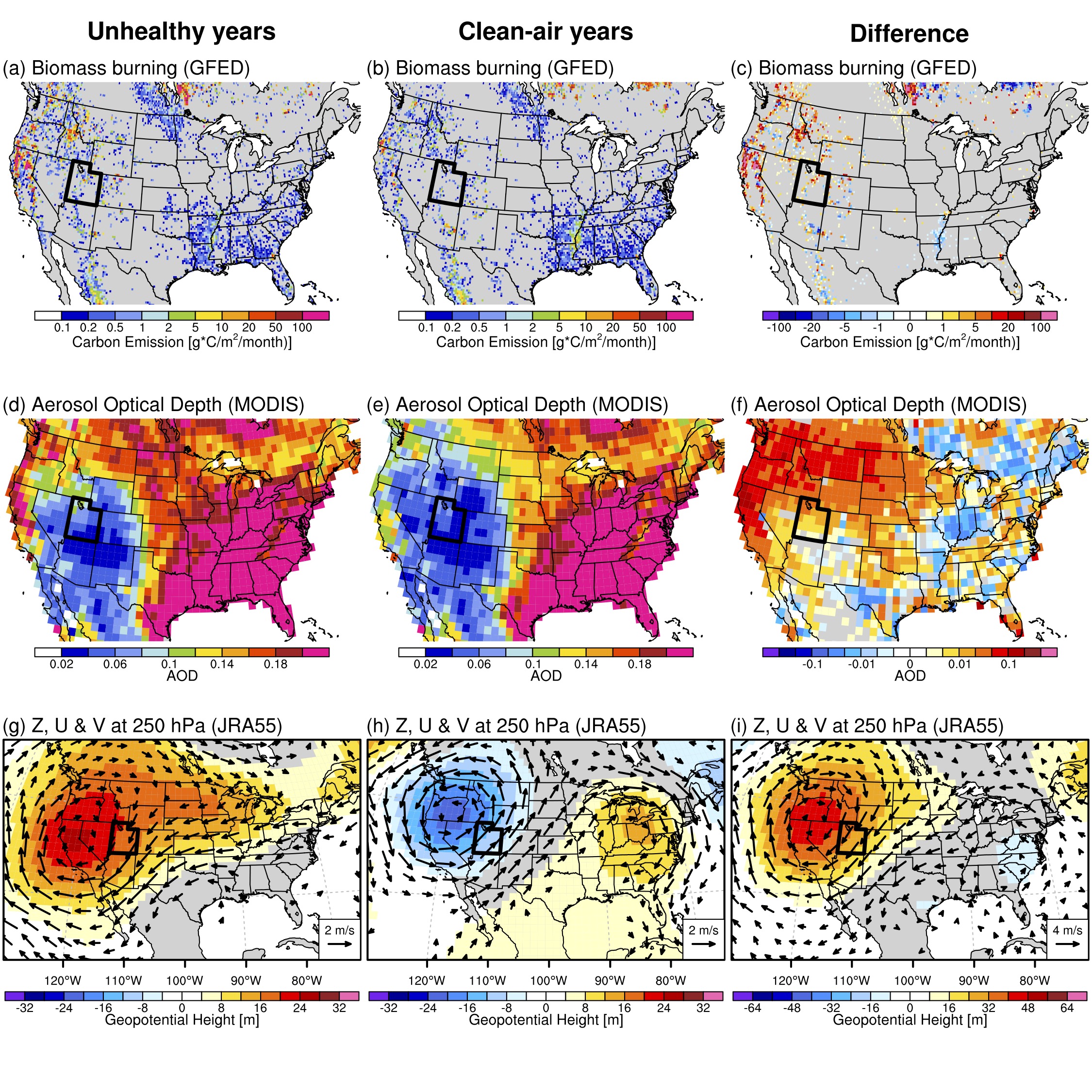
Compound Effects
Understanding how large-scale climate drivers shape compound hazards—such as drought, wildfire, poor air quality, and ecological stress—in western North America.
Climate Drivers of Compound Effects
Climate variability and long-term change influence drought conditions that trigger a cascade of compound impacts, including reduced water availability, larger wildfires, degraded air quality, and vegetation stress—particularly across the western United States. For example, our research shows that a persistent high-pressure ridge over the eastern North Pacific induces hot and dry summer conditions, which enhance wildfire risk in the Pacific Northwest and transport smoke into downstream regions such as Utah. By revealing the Earth system mechanisms linking climate anomalies to regional atmospheric circulation and their ecological and societal consequences, this work informs preparedness and long-term adaptation strategies.
Key Publications:- Zhang et al. (2024, Environ. Res. Lett.): A weather pattern responsible for increasing wildfires in the Western United States
- Chikamoto et al. (2023, Environ. Res. Lett.): Compound impacts of climate variability on western U.S. drought and fire risk
- Chikamoto et al. (2017, Sci. Rep.): Multi-year predictability of climate, drought, and wildfire in southwestern North America
- Chikamoto et al. (2015, Clim. Dyn.): Decadal predictability of soil water, vegetation, and wildfire frequency over North America
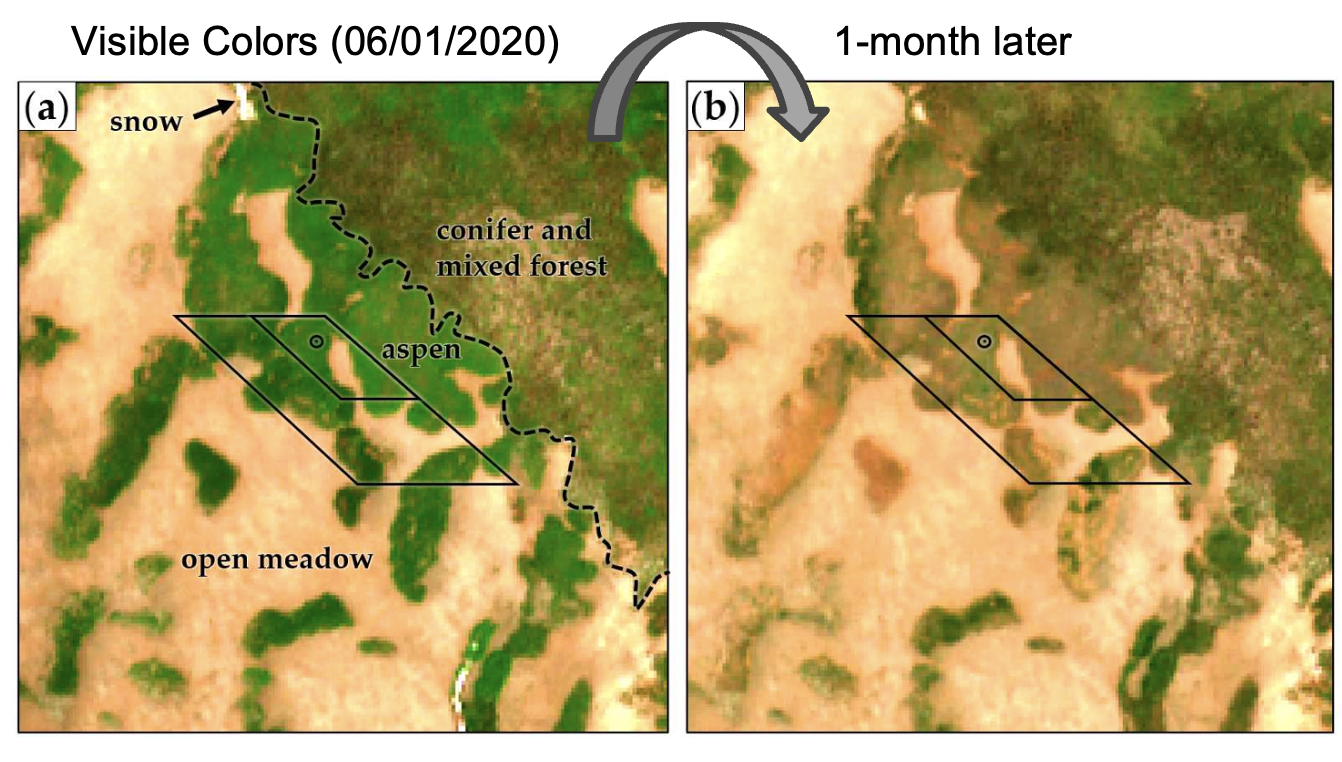
Climate Adaptation
Understanding how climate variability and change impact local ecosystems, land use, and community decision-making across the western United States and beyond.
Real-World Applications of Climate Science
Our research explores the tangible impacts of climate variability and change on ecosystems, agricultural practices, and local communities. We focus on detecting climate-induced ecosystem stress, assessing historical and future risks to forests, evaluating recreational ecosystem services, and supporting adaptation strategies for land managers and agricultural producers. These studies provide actionable insights for sustainable land use, ecosystem resilience, and climate-informed planning.
Key Publications:- Wright et al. (2024, Remote Sens.): Detection of growing season freeze-induced defoliation in aspen forests
- Birch et al. (2023, Ecosystems): Long-term growth reductions from frost defoliation in Populus tremuloides
- Wilkins et al. (2021, Glob. Environ. Change): Climate change and recreational ecosystem services on public lands
- Akbar et al. (2020, Climate): Rancher adaptation strategies to climate variability in the Upper Colorado River Basin
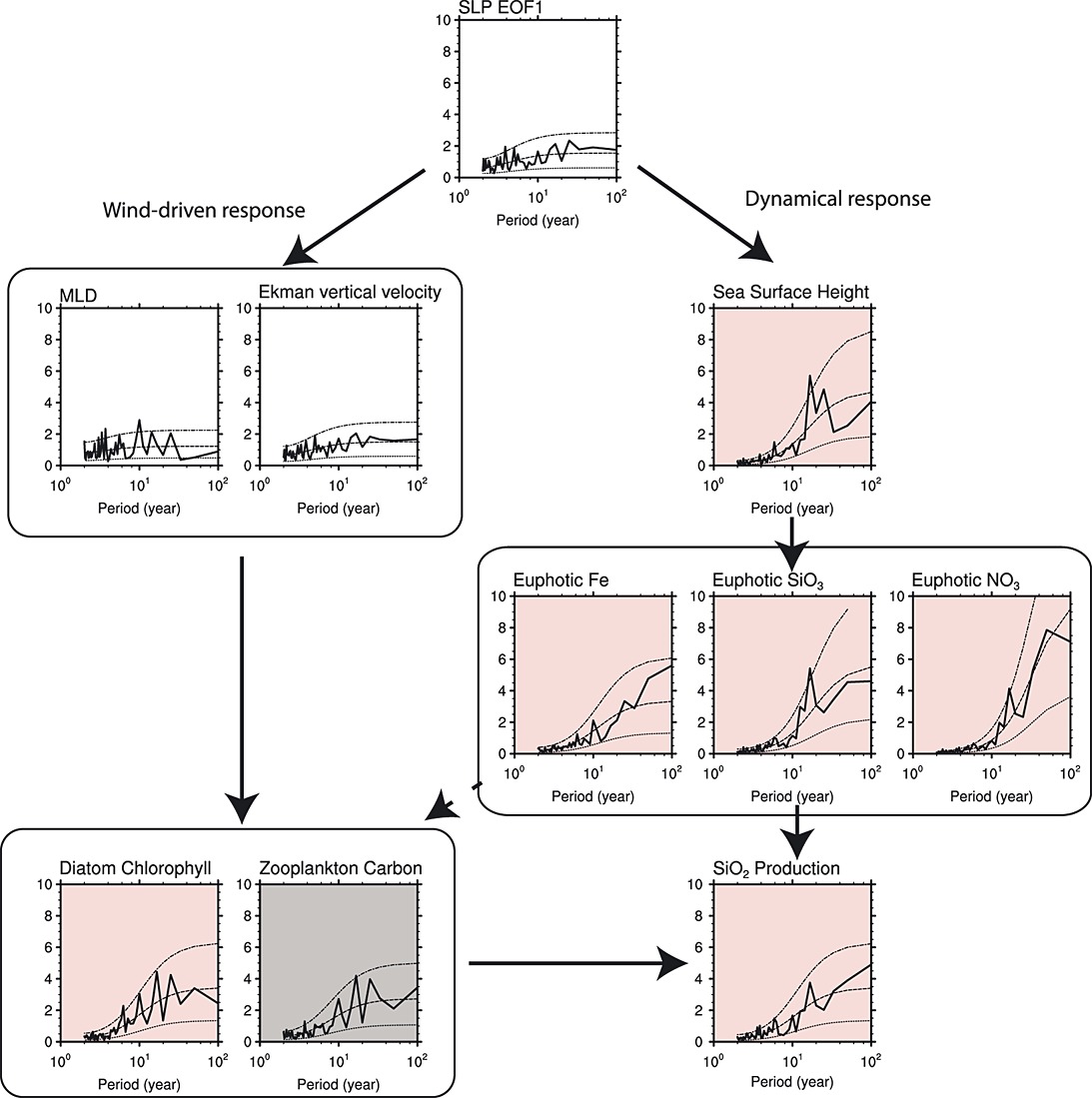
Marine Ecosystem
Exploring the multi-year variability and predictability of marine ecosystems in response to large-scale ocean-atmosphere climate modes across the North Pacific and beyond.
Forecasting Marine Ecosystem Variability on Climate Timescales
Our research investigates the mechanisms behind multi-year variability of marine ecosystems, particularly in the North Pacific. Using coupled climate-biogeochemistry models and observational analyses, we demonstrate that modes of climate variability such as the Pacific Decadal Oscillation and ENSO strongly influence biological productivity patterns. Understanding these connections improves predictability of marine ecosystem health and supports sustainable ocean management strategies.
Key Publications: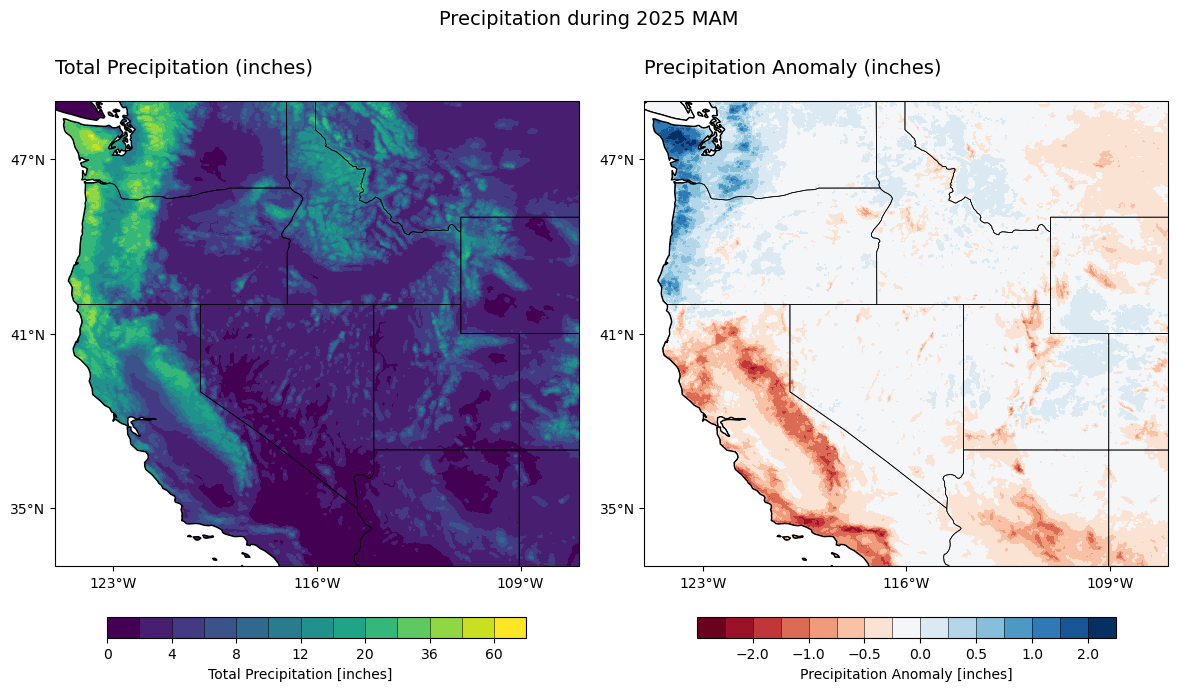
S2S Forecasting
Advancing Subseasonal-to-Seasonal (S2S) forecasting systems to improve hydroclimate predictions using statistical downscaling, high-resolution modeling, and multi-model ensembles.
Improving Subseasonal-to-Seasonal Forecasts for Regional Climate Applications
Our research develops and evaluates forecasting systems on subseasonal-to-seasonal (S2S) timescales, targeting atmospheric and oceanic variables such as precipitation, sea level, and convective activity. We assess multiple tools, including fully coupled climate models, global atmospheric models, regional weather models, ensemble generation methods, and both dynamical and statistical downscaling approaches. These studies not only advance the scientific foundations of climate modeling frameworks, but also provide broad societal benefits by improving climate forecast applications for drought planning, water management, and hazard mitigation.
Key Publications:- Vernon et al. (2025, Environ. Res. Lett.): Improving seasonal precipitation forecasts through statistical downscaling
- Chang et al. (2024, JGR: Atmospheres): Enhancing extreme precipitation predictions with convection-permitting modeling
- Long et al. (2021, JGR: Oceans): Seasonal forecasting skill of sea level anomalies in a multi-model framework
- Chikamoto et al. (2007, GRL): Bred vectors and tropical intraseasonal oscillation growth
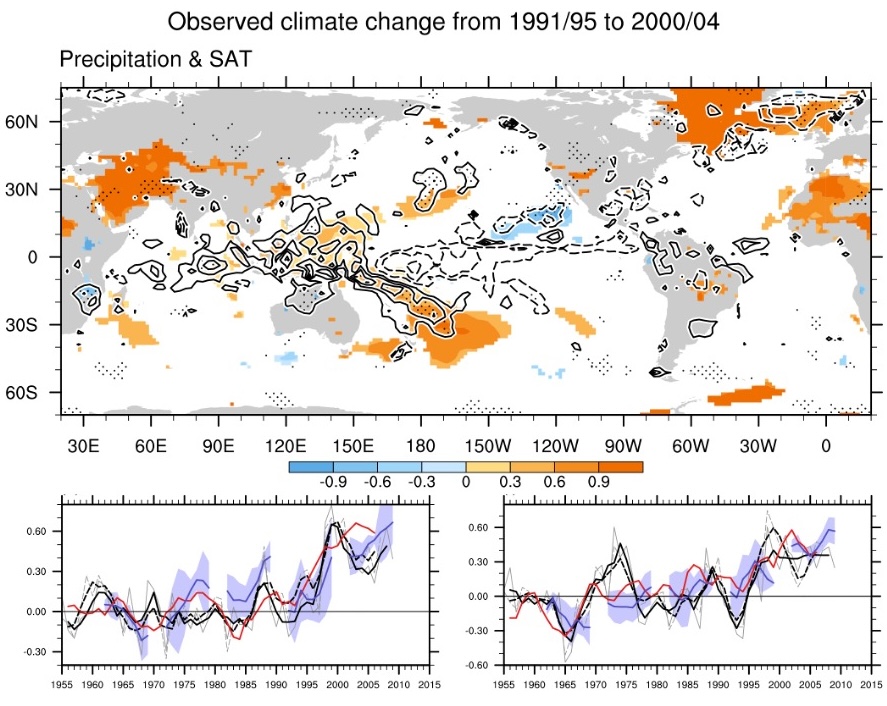
Decadal Forecasting
Advancing decadal climate prediction systems to quantify near-term climate variability under a changing climate.
Decadal Climate Prediction and Initialization Techniques
Our research develops and assesses decadal forecasting systems to improve our understanding of near-term climate predictions, which requires combined knowledge of internal variability and externally forced changes. We focus on reducing model drift and initialization shocks, improving ocean data assimilation techniques, and evaluating multi-model ensemble skill. These efforts enhance our ability to forecast low-frequency climate modes such as the Pacific Decadal Oscillation, North Pacific Gyre Oscillation, and Atlantic Multidecadal Oscillation, as well as their subsequent impacts on Earth system processes across seasonal-to-multi-decadal timescales.
Key Publications:- Chikamoto et al. (2019, J. Climate): A drift-free decadal climate prediction system for CESM
- Doblas-Reyes et al. (2013, Nat. Commun.): Initialized near-term regional climate change prediction
- Chikamoto et al. (2013, Climate Dyn.): Decadal predictability in a MIROC multi-model ensemble
- Tatebe et al. (2012, J. Meteor. Soc. Japan): Ocean initialization for MIROC decadal prediction
- Mochizuki et al. (2012, J. Meteor. Soc. Japan): MIROC-based decadal prediction system
- Chikamoto et al. (2012, J. Meteor. Soc. Japan): Predictability of a stepwise shift in Pacific climate during the late 1990s
- Toyoda et al. (2011, SOLA): Sea ice data assimilation for Arctic climate prediction
- Mochizuki et al. (2010, PNAS): Pacific Decadal Oscillation hindcasts for near-term prediction
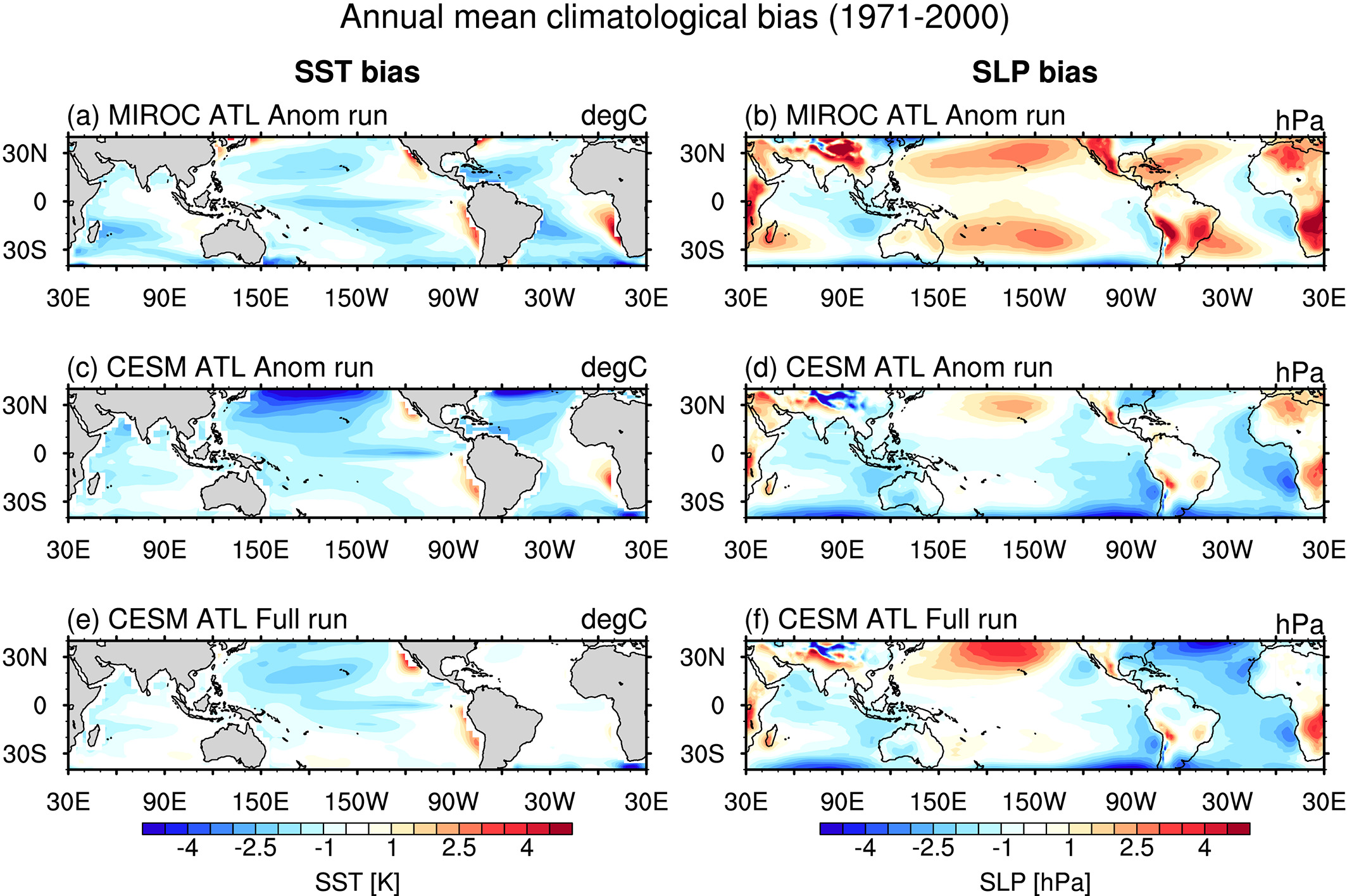
Partial Ocean Assimilation (POA)
Investigating the role of basin-specific ocean variability on climate predictability through partial ocean data assimilation experiments.
Partial Ocean Assimilation to Diagnose Climate Predictability
Our research applies partial ocean data assimilation techniques to better understand how variability in specific ocean basins, such as the Pacific, Atlantic, and Indian Oceans, influences global and regional climate variability and predictability. By selectively initializing only parts of the ocean, we isolate basin impacts on interannual-to-decadal timescales, examine inter-basin interactions, and improve seasonal and multi-year forecasts. This approach advances our understanding of trans-basin teleconnections, extreme event precursors, and regional climate predictability.
Key Publications:- Chikamoto et al. (2024, J. Climate): Tropical inter-basin interactions and spring precipitation variability
- Stuivenvolt-Allen et al. (2023, J. Climate): Growing Pacific linkage with western North Atlantic explosive cyclogenesis
- Stuivenvolt-Allen et al. (2021, JGR: Atmospheres): Atmospheric rivers and quasi-decadal variability
- Chikamoto et al. (2020, JGR: Oceans): ENSO evolution modulated by Atlantic forcing
- Johnson et al. (2020, Climate Dyn.): Remote forcing of Pacific Decadal Oscillation by the Atlantic
- Chikamoto et al. (2019, J. Climate): A drift-free decadal climate prediction system for CESM
- Johnson et al. (2018, Climate): Ocean impacts on Australian precipitation variability
- Ham et al. (2017, Climate Dyn.): Tropical Atlantic–Korea teleconnection during boreal summer
- Purich et al. (2016, J. Climate): Tropical Pacific SST drivers of Antarctic sea ice trends
- Chikamoto et al. (2016, GRL): Atlantic impacts on Pacific decadal trends
- Mochizuki et al. (2016, GRL): Indian Ocean effects on Pacific decadal variability
- Chikamoto et al. (2015, Nat. Commun.): Skilful multi-year predictions of tropical trans-basin variability
Funded Research Projects
Full Title: Assessing the Impacts of Persistent La Niña on Utah's Drought Risk to Strengthen Community Resilience
This project investigates how persistent La Niña events affect drought risk in Utah, aiming to improve seasonal drought forecasts and establish a drought warning system to support community preparedness in a warming climate.
Sponsor: U.S. Geological Survey and Utah Center for Water Resources Research
Role: PI
Award Number: G21AP10623-04
Period: 2024-09 to 2025-08
Full Title: Developing a Climate-Smart Weather Metric to Mitigate Growing Season Freeze Damage
This project evaluates growing-season freeze events and their impacts on aspen forests and fruit crops in Utah, using historical weather data, climate modeling, and satellite analysis to support climate-smart agriculture and landscape resilience under a changing climate.
Sponsor: Utah Agricultural Experiment Station Seed Grant
Role: PI
Period: 2024-08 to 2026-06
Full Title: Enhancing Multi-Year-to-Decadal Forecasting for the Colorado River Water Supply and Large Reservoirs
This project extends the lead time of multi-year forecasts for Colorado River water supply using dynamical climate prediction systems from seasonal to decadal scales, integrated into a web-based platform hosted by the Utah Climate Center.
Sponsor: Department of the Interior, Bureau of Reclamation, WaterSMART Program
Role: PI
Award Number: R24AP00321
Period: 2024-07 to 2026-09
Full Title: Predicting Spring Runoff for Utah Water Managing Water Resources in Utah
This project predicts snowmelt and rainfall runoff across Utah using hydrological models driven by downscaled climate forecasts, and delivers seasonal to multi-decadal runoff projections via a web-based platform to support water resource planning.
Sponsor: Utah State University, Extension Water Initiative
Role: Co-PI
Period: 2024-05 to 2026-04
Full Title: Securing the Future of the Great Salt Lake Basin Through Effective Water and Land Use Partnerships
This project builds a community-driven, cross-sector network to improve land and water use planning in the Great Salt Lake Basin by integrating scenario modeling, policy analysis, and a novel resilience assessment tool to enhance regional water security and ecosystem health.
Sponsor: National Science Foundation, Civic Innovation Challenge
Role: Co-PI
Award Number: 2228718
Period: 2022-10 to 2023-03
Full Title: A Framework for Improving Analysis and Modeling of Earth System and Intersectoral Dynamics at Regional Scales
This project expands engagement with diverse stakeholders, advances understanding of coupled human–Earth system processes, and evaluates climate model and data credibility to support long-term decision-making.
Sponsor: Department of Energy
Role: Co-PI
Award Number: DESC0016605
Period: 2022-09 to 2025-08
Full Title: Developing High-Resolution Seasonal Snow Forecasts for Utah's Watersheds
This project develops watershed-scale forecasts of snow water equivalent in Utah up to 9 months in advance by combining climate model outputs, snow physics models, and machine-learning-based downscaling to support drought risk management and water planning.
Sponsor: U.S. Geological Survey and Utah Center for Water Resources Research
Role: Co-PI
Award Number: G21AP10623-04
Period: 2022-09 to 2023-08
Full Title: A platform for drought forecast in Intermountain West with the optimized multi-model ensemble approach
This project develops a web-based platform for high-resolution seasonal drought forecasts in the Intermountain West by optimizing and downscaling forecast products from the North American Multi-Model Ensemble.
Sponsor: Department of the Interior, Bureau of Reclamation, WaterSMART Program
Role: Co-I
Award Number: R22AP00220
Period: 2022-05 to 2024-03
Full Title: Modeling the Climate-Water-Food Nexus in the Intermountain West: A Drought Perspective
This project uses a fully coupled regional climate–land–crop model to simulate how climate, irrigation, and crop systems interact under drought in the Intermountain West, aiming to inform resource management and adaptation strategies.
Sponsor: Utah Agricultural Experiment Station Seed Grant
Role: Co-I
Period: 2021-08 to 2023-07
Full Title: Climate Drivers for Widespread Aspen Defoliation Events in the Cedar Mountain Area
This project assesses how late-spring freeze events affect aspen defoliation by analyzing historical weather station data and white ring formation in tree cores.
Sponsor: Utah State University, Cedar Mountain Initiative
Role: PI
Period: 2021-07 to 2024-06
Full Title: A platform toward an early warning system for shortages in Colorado River water supply
This project develops a web-based platform for multi-year forecasts of Colorado River water supply, bridging the gap between scientific insight and operational drought planning in the Intermountain West.
Sponsor: Department of the Interior, Bureau of Reclamation
Role: PI
Award Number: R19AP00149
Period: 2020-08 to 2022-09
Full Title: Useful Prediction of Climate Extreme Risk for Texas-Oklahoma at 4–6 Years
This project improves multi-year forecasts of weather extremes in the southern Great Plains by integrating a decadal climate prediction system with a cloud-resolving regional weather model to support DoD disaster planning and risk assessment.
Sponsor: Department of Defense, Strategic Environmental Research and Development Program
Role: Co-PI
Award Number: RC20-3056
Period: 2020-08 to 2023-09
Full Title: Improving Multi-Year Hydrological Predictability in the Intermountain West
This project explores how long-term ocean memory and land processes contribute to multi-year streamflow predictability in the Intermountain West, using decadal Earth system modeling to improve water resource forecasts and support drought and disaster management.
Sponsor: Utah Agricultural Experiment Station Seed Grant
Role: PI
Period: 2020-08 to 2022-07
Full Title: Synthesizing drought characteristics prediction to inform drought resiliency decisions from days to years
Developing a drought forecast system for Utah using decadal prediction and water cycle modeling to support proactive water management.
Sponsor: Department of the Interior, Bureau of Reclamation, WaterSMART Program
Role: Co-PI
Award Number: R18AC00018
Period: 2018-09 to 2020-09
Applications
Colorado River Water Supply Forecast
Real-time platform forecasting multi-year hydroclimate risk and water availability for the Colorado River Basin.
View ForecastWestern Drought Outlook
A seasonal drought prediction system combining observational analyses and model-based forecasts for the western U.S.
View Outlook